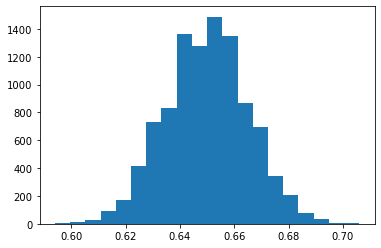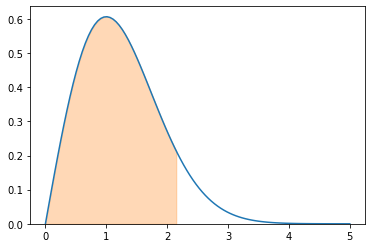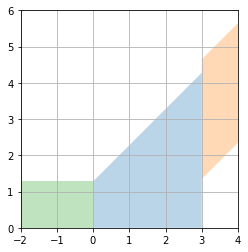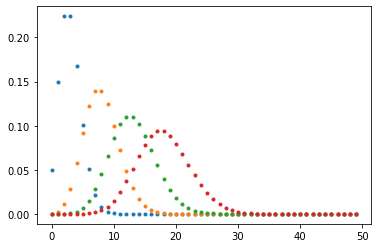Confidence intervals example
Based loosely on A very friendly introduction to confidence intervals
import numpy as np
import scipy.stats
import scipy.stats as stats
import matplotlib.pyplot as plt
Let's look at taking a small sample of a larger distribution. We'll use the same example given in the reference; this was a poll of the people in the US to see what fraction likes Soccer. Let's assume for the moment we know the real mean, and have the original distribution handy:
love_soccer_prop = 0.65 # Real percentage of people who love soccer
total_population = 325 * 10 ** 6 # Total population in the U.S. (325M)
# Note: 325e6 would be a floating point number
love_soccer_num = int(love_soccer_prop * total_population)
Bools are smaller than ints, and we can still take the mean, sum, etc. of an array of bools, so we'll use bools. We'll start off with a "sorted" array (people who love Soccer first), we we'll need to be careful when we select samples from it.
population = np.zeros(total_population, dtype=bool)
population[:love_soccer_num] = True
np.mean(population)
for i in range(10):
sample = np.random.choice(population, size=1000)
print(f"Sample {i}: {np.mean(sample)}")
values = np.empty(10_000)
for i in range(len(values)):
values[i] = np.mean(np.random.choice(population, size=1_000))
np.mean(values)
plt.hist(values, bins=20)
plt.show()
confidence = 0.95
sem = np.std(sample) / np.sqrt(len(sample)) # scipy.stats.sem(sample)
h = sem * scipy.stats.t.ppf((1 + confidence) / 2, len(sample) - 1)
print(f"{np.mean(sample)} +/- {h:.3g} ({confidence:.1%})")
For larger samples (more than 100), we can approximate the student's t distribution with a Gaussian:
sem = scipy.stats.sem(sample)
h = sem * scipy.stats.norm.ppf((1 + confidence) / 2)
print(f"{np.mean(sample)} +/- {h:.3g} ({confidence:.1%})")
In SciPy, we can do this even quicker:
h = scipy.stats.t.interval(confidence, len(sample) - 1, loc=np.mean(sample), scale=sem)
print(h)
Anaconda includes another popular package for statistics: StatsModels, which complements scipy.stats and pandas.
import statsmodels.stats.api as sms
inter = sms.DescrStatsW(sample).tconfint_mean()
inter
Physics confidence intervals
Based on the excellent slides here: http://www.phas.ubc.ca/~oser/p509/Lec_16.pdf
For simplicity, we will assume that we are using 90% confidence intervals in the notes below.
In Physics, frequentist confidence intervals are often used for measurements. We make a measurement, then construct a confidence interval from the expected underlying probability distribution for the different possible measurements; we quote the true values for which our measurement is in the 90% range.
This does not tell us that there is a 90% chance the true value is in this range, rather that if we did this experiment many times, 90% of the experiments would contain the true value.
If we have the following distribution, the Neyman confidence interval construction does not specify how to draw the confidence region; any region that contains 90% of the probability could be a 90% confidence interval.
$$ \mathrm{PDF}(x) = x e^{-\frac{1}{2} x^2} $$import sympy as s
s.init_printing()
x = s.symbols("x")
f = x * s.exp(-(x ** 2) / 2)
f.integrate(x)
This is normalized:
f.integrate((x, 0, s.oo))
This is one region:
f.integrate((x, 0.32, 2.45))
fn = s.lambdify([x], f)
xs = np.linspace(0, 5, 100)
plt.plot(xs, fn(xs))
xs = np.linspace(0.32, 2.45, 50)
plt.fill_between(xs, fn(xs), color="C1", alpha=0.3)
plt.ylim(ymin=0)
plt.show()
You can also choose an upper limit:
f.integrate((x, 0, 2.15))
xs = np.linspace(0, 5, 100)
plt.plot(xs, fn(xs))
xs = np.linspace(0, 2.15, 50)
plt.fill_between(xs, fn(xs), color="C1", alpha=0.3)
plt.ylim(ymin=0)
plt.show()
How about this?
f.integrate((x, 0, 1.09)) + f.integrate((x, 1.26, s.oo))
xs = np.linspace(0, 5, 100)
plt.plot(xs, fn(xs))
xs = np.linspace(0, 1.09, 50)
plt.fill_between(xs, fn(xs), color="C1", alpha=0.3)
xs = np.linspace(1.26, 5, 50)
plt.fill_between(xs, fn(xs), color="C1", alpha=0.3)
plt.ylim(ymin=0)
plt.show()
For fixed true value $\mu$, 90% of the probability lies in $\mu-1.28<\hat{\mu}<\infty$. Or $\mu-1.65<\hat{\mu}<\mu+1.65$.
fig, ax = plt.subplots()
# Upper limit quote
x = np.linspace(0, 3)
ax.fill_between(x, 1.28 + x, alpha=0.3)
# Upper and lower bounds
x = np.linspace(3, 4)
ax.fill_between(x, 1.65 + x, x - 1.65, alpha=0.3)
# Quote as 0
x = np.linspace(-2, 0)
ax.fill_between(x, 1.28 + x * 0, alpha=0.3)
ax.set_xlim(-2, 4)
ax.set_ylim(0, 6)
ax.grid()
ax.set_aspect("equal")
plt.show()
From out previous example, $\mu_\mathrm{best}=x$ if $x>0$ or $\mu_\mathrm{best}=0$ if $x\le 0$
import gammapy.stats as gstats
x_bins = np.arange(0, 50)
mu_bins = np.linspace(0, 15, int(15 / 0.005) + 1, endpoint=True)
matrix = [stats.poisson(mu + 3.0).pmf(x_bins) for mu in mu_bins]
plt.plot(matrix[0], ".")
plt.plot(matrix[1000], ".")
plt.plot(matrix[2000], ".")
plt.plot(matrix[-1], ".")
acceptance_intervals = gstats.fc_construct_acceptance_intervals_pdfs(matrix, 0.9)
LowerLimitNum, UpperLimitNum, other = gstats.fc_get_limits(
mu_bins, x_bins, acceptance_intervals
)
u = np.array([gstats.fc_find_limit(i, UpperLimitNum, mu_bins) for i in range(14)])
l = [gstats.fc_find_limit(i, LowerLimitNum, mu_bins) for i in range(14)]
plt.step(range(14), u, where="post", label="Upper limit")
plt.step(range(14), l, where="post", label="Lower limit")
plt.xticks(range(15))
plt.yticks(range(16))
plt.grid()
plt.xlabel("Measured")
plt.ylabel("True")
plt.show()







